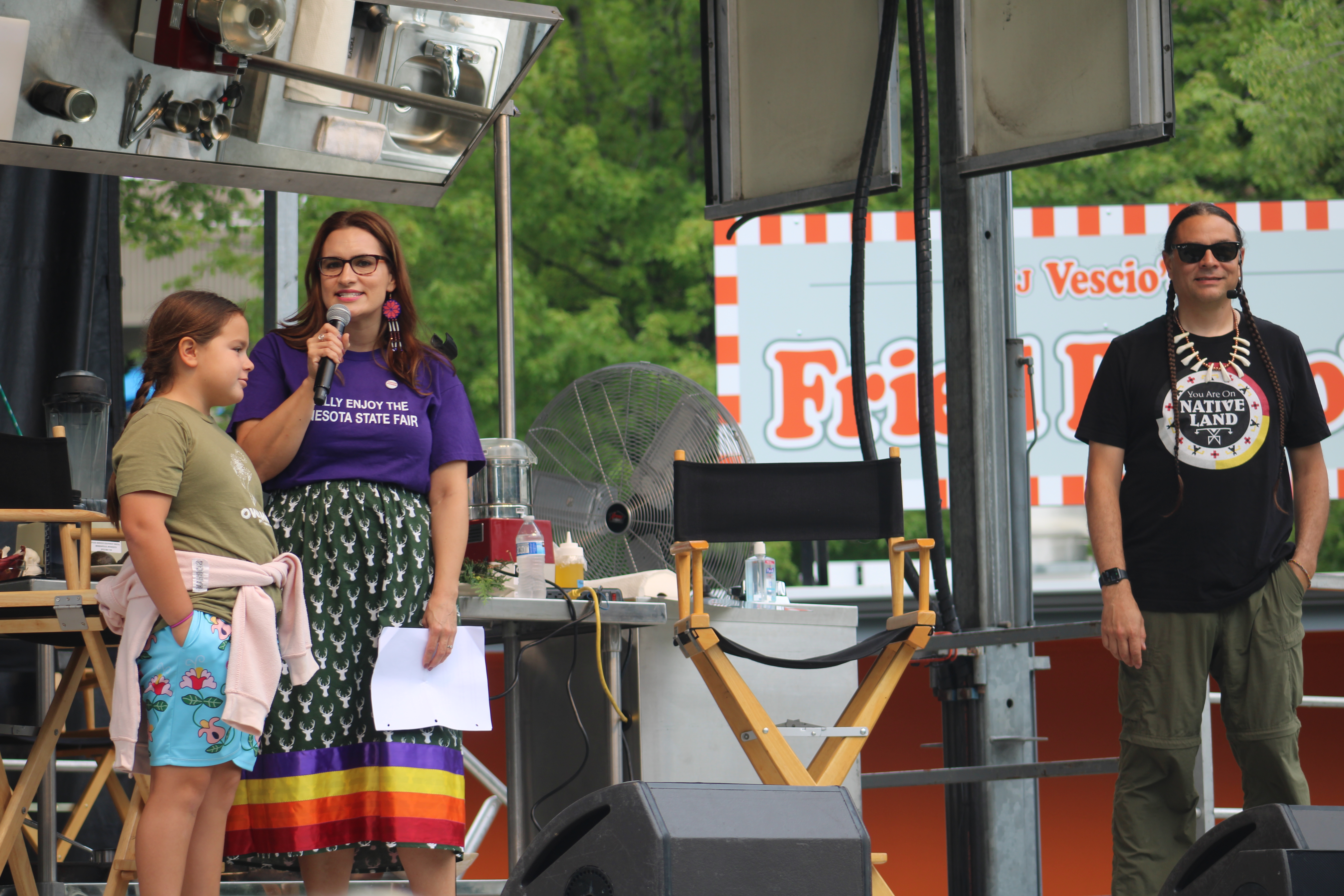
- Details
- By Darren Thompson
SAINT PAUL, Minn.—The Minnesota State Fair opened to thousands of attendees last week, kicking off the popular annual 12-day event to celebrate all things Minnesotan, including Indigenous people and culture.
While Indigenous culture has been visible in previous years, this year Native American representation takes the stage, literally, to showcase one of the most popular reasons people attend the fair: food.
On Sunday, the North American Traditional Indigenous Food Systems (NATIFS), the nonprofit arm of the award-winning Native-owned restaurant Owamni, organized a full day of presentations featuring Indigenous music and food at Dan Patch Stage, one of the fair’s interactive stages. Indigenous chefs Sean Sherman, Dana Thompson and others from NATIFS and Owamni talked about Indigenous foods and Minnesota Indigenous music artists such as Keith Secola and hip-hop artist Tall Paul.
“It’s tough to talk about healthy eating and Indigenous foods while at the state fair,” said Owamni Chef and Co-Owner Sherman during Sunday’s presentation. Sherman joined with NATIFS Outreach Director Ron Kinneen (Tlingit) in a discussion about the colonization of food and its effects on Indigenous people.
Sugar, flour, and dairy — all foods celebrated at the fair — have had a drastic impact on Native Americans. Sherman said that in some Indigenous communities, up to 60 percent of the population has some form of diabetes.
'A part of Minnesota'
Coined the “The Great Minnesota Get-Together,” the fair had its beginnings in the 1850s, but highlighting Indigenous culture hasn’t always been a priority. It wasn’t until 2019 that all the state’s 11 tribes were showcased together at the fair’s education building in an interactive display.
“It is so exciting to see the growth in Indigenous representation at the Minnesota State Fair,” Minnesota Lieutenant Governor Peggy Flanagan, a citizen of White Earth Band of Ojibwe, said as she opened Sherman and Kinneen’s presentation on Sunday. “Indigenous lifeways, and our history, are a part of Minnesota and they belong at the state fair,” she said.
Rob Kelsey has been attending the Minnesota State Fair for 76 years. Kelsey has collected more than 1,300 cotton cloth seed sacks — the largest collection in the world. He displays nearly 400 cloth bags at the fair in the agricultural building.
Many of the sacks are brightly colored with printed advertising logos, slogans and pictures. In the late 1950s, paper sacks replaced the cloth ones, and today nearly all seed corn is sold in paper sacks.
“The most expensive ones are the ones that have images of Native people on them,” Kelsey said. When asked why he thinks those bags are prized the most, he said it is because of their intricate designs.
Kelsey also oversees the fair’s contests for scarecrows, seed art and corn. Asked about the distinction of corn varieties, Kelsey replied, “It’s all Indian corn.”
More Stories Like This
Native News Weekly (August 25, 2024): D.C. BriefsUS Presidents in Their Own Words Concerning American Indians
Indigenous Actor Elaine Miles Reports Detention by Alleged ICE Agents
Happy Thanksgiving from Native News Online
Coming Up on Native Bidaské: Behind the Animation: Joey Clift Talks “Pow” and Native Storytelling
Help us tell the stories that could save Native languages and food traditions
At a critical moment for Indian Country, Native News Online is embarking on our most ambitious reporting project yet: "Cultivating Culture," a three-year investigation into two forces shaping Native community survival—food sovereignty and language revitalization.
The devastating impact of COVID-19 accelerated the loss of Native elders and with them, irreplaceable cultural knowledge. Yet across tribal communities, innovative leaders are fighting back, reclaiming traditional food systems and breathing new life into Native languages. These aren't just cultural preservation efforts—they're powerful pathways to community health, healing, and resilience.
Our dedicated reporting team will spend three years documenting these stories through on-the-ground reporting in 18 tribal communities, producing over 200 in-depth stories, 18 podcast episodes, and multimedia content that amplifies Indigenous voices. We'll show policymakers, funders, and allies how cultural restoration directly impacts physical and mental wellness while celebrating successful models of sovereignty and self-determination.
This isn't corporate media parachuting into Indian Country for a quick story. This is sustained, relationship-based journalism by Native reporters who understand these communities. It's "Warrior Journalism"—fearless reporting that serves the 5.5 million readers who depend on us for news that mainstream media often ignores.
We need your help right now. While we've secured partial funding, we're still $450,000 short of our three-year budget. Our immediate goal is $25,000 this month to keep this critical work moving forward—funding reporter salaries, travel to remote communities, photography, and the deep reporting these stories deserve.
Every dollar directly supports Indigenous journalists telling Indigenous stories. Whether it's $5 or $50, your contribution ensures these vital narratives of resilience, innovation, and hope don't disappear into silence.
 The stakes couldn't be higher. Native languages are being lost at an alarming rate. Food insecurity plagues many tribal communities. But solutions are emerging, and these stories need to be told.
The stakes couldn't be higher. Native languages are being lost at an alarming rate. Food insecurity plagues many tribal communities. But solutions are emerging, and these stories need to be told.
Support independent Native journalism. Fund the stories that matter.
Levi Rickert (Potawatomi), Editor & Publisher
